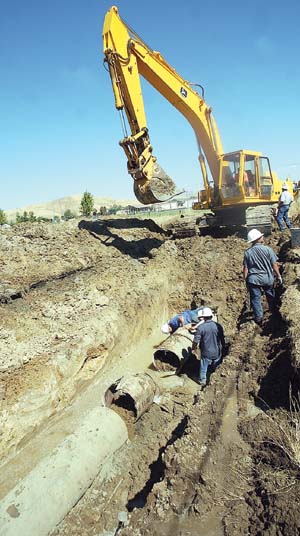About a half-million gallons of untreated water gushed from a
broken water main near Tres Pinos School on Wednesday but didn’t
damage any homes or farm fields in the area.
About a half-million gallons of untreated water gushed from a broken water main near Tres Pinos School on Wednesday but didn’t damage any homes or farm fields in the area.
The break happened northwest of Hollister along Highway 25 and the Tres Pinos Creek and adjacent to Best Road, according to San Benito County Water District manager John Gregg.
The break occurred shortly after 5 p.m. on Wednesday, but the water district didn’t realize it for about 30-45 minutes, Gregg said. During that time, about 10,000 to 15,000 gallons of water a minute rushed out of the pipe. The water is mostly used for farming and watering golf courses, but also serves some drinking water to modest-sized subdivisions after going through additional treatment.
The water district had to stop sending drinking water to residents in the Stonegate and Vineyard Estates subdivisions; a small plant in the area treats the water for household purposes, Gregg said. But those residents largely weren’t affected because there’s a limited supply of water storage intended for such events, he said. And the water district expects to complete repairs of the pipe by late Friday, Gregg said.
In the meantime, the water district advised residents to use their water conservatively, Gregg said. Sundown Lane resident Kim Randl said her water was working fine Thursday evening, but a note had been left on her door to conserve it, she said.
“It’s not good but it’s not a crisis,” Gregg said Thursday.
Gregg couldn’t pinpoint a cause for the break because there was no unusual activity in the area, he said. He mentioned, though, a power failure occurred at around that time, which may have led to “pressure fluctuations” in the pipe system, he said.
Gregg believes the Stonegate subdivision is especially vulnerable to water supply interruption. He said it should have a more reliable alternative source of water, such as a well.
And a poor quality pipe used in the system, made of fiberglass that was popular in the 1980s, also may have led to it blowing up, he said.
“It turns out that it fails catastrophically,” he said.
For now, though, the water district must get by with what it has, he said.
“It terms of affordable solutions, this is the pipe we’ve got,” he said.
The failure also automatically shut off the nearby LESSALT water treatment plant operated by the Sunnyslope Water District. But it was back running one-and-a-half hours later, Gregg said. The event had no effect on Sunnyslope’s customers, according to that district’s director, Bryan Yamaoka.
The spill seeped into the dry field in the area but didn’t reach the nearby school or any homes. The pipe repairs by a water district crew were still under way at press time. Gregg said it had been about three years since a main break of similar size in the district.
“You can see it’s been wet, but it’s pretty well soaked in right now,” Gregg said Thursday evening.









